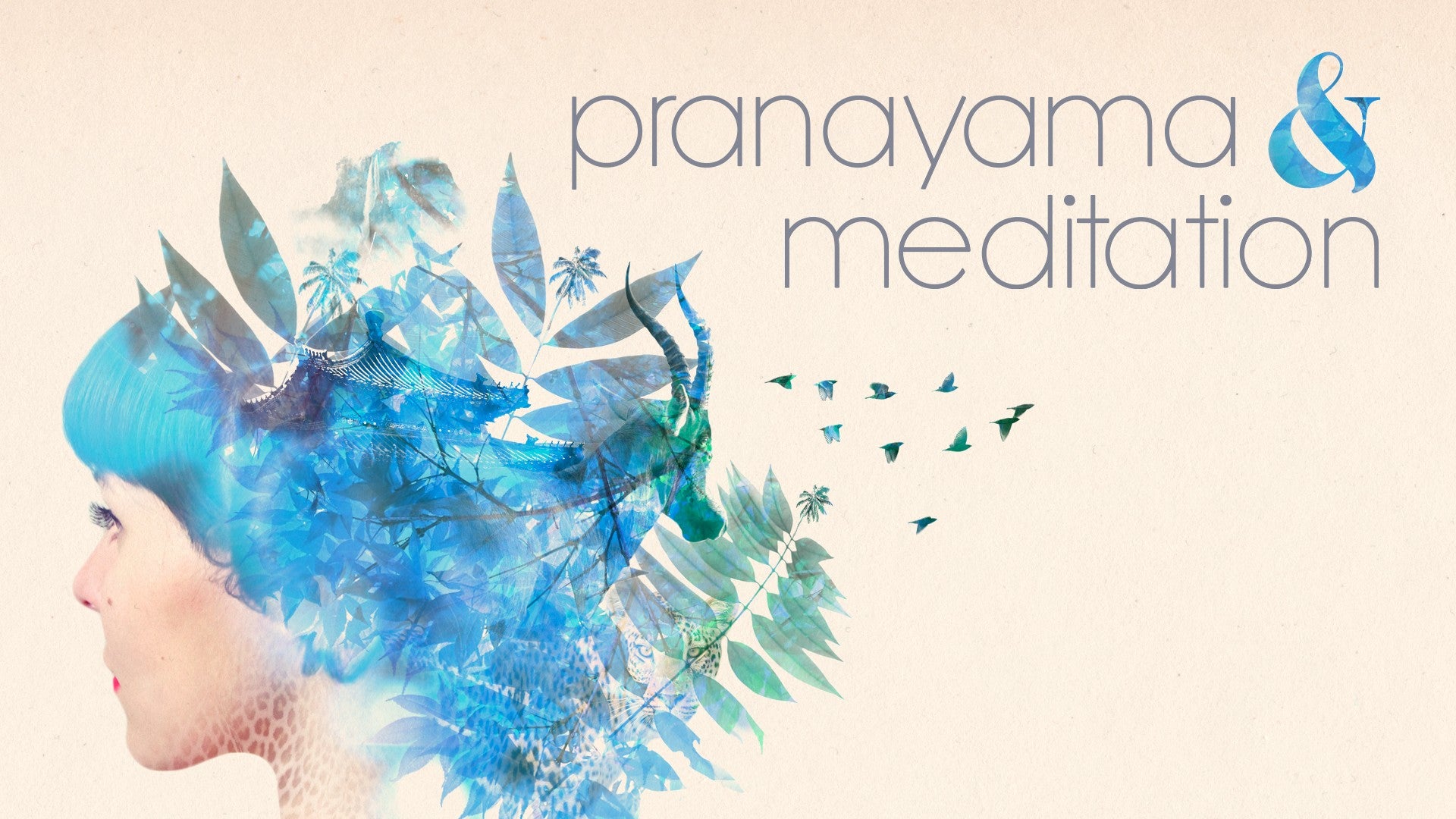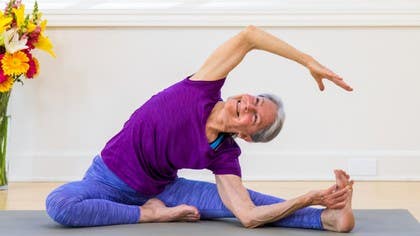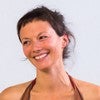Description
About This Video
Transcript
Read Full Transcript
Hi, welcome. In this session we're going to be working with tuning in to different sides of the body as we're breathing in a few asanas, a few postures. And then in the end we'll sit and go into a more refined experience of awareness in the nostrils. Okay, so I'm going to begin this session coming into a pigeon pose, and I'm going to be using my special friend, the block. And I like to use thinner blocks when I'm doing pigeon pose because I'm going to be placing it, when I get my leg into pigeon, I'm going to be placing it on the inside of my thigh. And I'm going to turn away from the block a little. You'll see when we do it.
And I'm going to then rotate down. And what this helps me do is to rotate this thigh outward so that the space here between the lower leg bone and the upper leg bone stays happy and spacious and not compressed. So you may find that after having the block there for a few seconds, you can just take it out and that will be sufficient. And you might find that you like to keep it there the entire time. So here we go, getting ready to come into our first side pigeon. We can take this from a downward dog or hands and knees. I like to get up into downward dog briefly.
And then bringing the knee, I usually bring it right near where the wrist is. See how that works for you. You're going to take the block and place it on the inner thigh. You're turning towards the hand that is supporting you. So I've got my left leg forward. You may have your right. And then you get your ribcage on the block, both hands on the floor, and turn the ribcage while compressing towards the thigh. And that externally rotates the thigh. And then you can come down a little deeper into the pose by walking your right foot back.
And partly because of this block being here, it's maybe not so comfortable to go all the way down with the forehead to the floor immediately. So you might have a second block here for your head or a nice firm pillow. And you may like to have the block on the high height, but it can also be turned down perhaps. So once you've gotten down and you start to feel your leg dropping, you can even turn your ribcage a little more. If it makes it too intense, you don't need to do that.
Also, sometimes you can feel really good to put that second block actually under the hip or a blanket. Wherever you are, which however you're using your props, just be quiet in the pose right now and see how it evolves for you for another 30 seconds or a minute. So the stretch can be altered a little bit by starting to come up. And this might be a good time to remove the block there and you can stay on the back block if you like. And then we'll turn the toes under on the back foot and start to bring the knee back to exit that side.
And it can feel very nice to maybe do a little cat cow in between, just sinking down in the upper back and lower back and tilting back. Either from your knees or downward dog. I showed it from downward dog last time, so I'm going to just be on hands and knees this time. You bring your opposite knee forward towards that same hand, wrist, foot comes to the inside, and then to come down into the pose, or before you come down into the pose, you're going to take this block again. You sort of turn pretty strongly away from it so that you can catch your side rib cage or side front and rotate back towards the center, which will give you a nice rotation in that thigh bone.
And then again, using this other block for head support or you could place it back behind the hip. Head support is nice because the shoulders and the neck release. I always notice my diaphragm in my belly, my belly breath feeling much happier. And then again, just settling in for a little while, relaxing into it as much as you can. Smooth, deep breath.
Each out breath just mentally occur, encouraging a release. It works. Your body is always wondering, what does she want me to do? What does he want me to do? Just relax. Just let go. All right. With an in breath, prepare yourself mentally to move the out breath. Place your hands, push yourself up, let the block be moved out of your way.
Turn the toes under on your back foot so you can start to shift and come back up to hands and knees. Okay. So I like that as a preliminary lead-in to Janu Sarsana. And Janu Sarsana is that pose where you've got one leg straight out in front of you and the other leg comes back. And I like to use my hand on the inside of the leg with the tendon. So when you're bringing your leg back to take it out to the side, if you try to lift the leg up with the hand more than the leg muscles itself, this joint closes and relaxes more easily.
Placing the foot anywhere between down near the knee to all the way up to the groin, your hip on that side moves back a little bit. And with that backward movement, then you're going to rotate yourself towards the straight leg. Now, not sure we need those for this, but we do want our belt. So you're going to take your belt and just lasso it over your foot and then lay it down and leave it there for when you're ready for it. I start this twist by a turn. So put your hands on the floor.
You can have fingertips on the floor on your mat pressing and helping you turn, or you can have the hands flat. And actually, one can use blocks for this. If they're on the sticky mat, you can press down and get a little turn. That feels kind of ergonomically nice on the elbow and the shoulder. Left leg is straight, left hand on the block pushing down.
This can help you to stay grounded in the opposite thigh, pressing down and actually forward, even though the block isn't moving. And then leaning forward with a straight back. And that comes from the front, really. A sense of wanting to lift from the front helps the back to straighten. And then if you can reach down and put your hand under the belt, you kind of slip in, let the back of the hand be on the inside of the belt, and then wrap your fingers around. And this hand is pulling.
But you never want to pull with this hand more than you're pushing with this hand. So the pushing hand balances you and gets you onto your seat, and the pulling hand helps you come forward. I find myself able to reach to the foot here, but don't be in a hurry for that. Just take your time. So for the first little while, we've been stretching forward and keeping the head in line with the spine, not closing the back of the neck in a sort of ambitious reach for the glory, but being calm and letting the forehead come down.
And then finally, for the last maybe 30 seconds or so, allow yourself to soften the belly backward to actually round a bit from the back body. Little or no pulling here. This is more a sense of release and longing forward from the crown towards the foot. Maybe you're ready for that other hand to come forward onto the foot. While you're here, just notice your left ribcage is the left side of your body, and your left ribcage is more available to experiencing the breath come in. Is that true for you? And how about the right nostril, with the right ribcage feeling more available to opening to the breath, the right lung?
Just feel into that with each in and out breath. How far down can that go for you? Down to the bottom of the ribcage, maybe further down into the belly, into the right hip crease and thigh. And then take note again of the back of your neck and the skull area, making sure that you're not pinching off there. Okay, and then one more breath with that awareness to the right side ribcage, right lung, right nostril. And as you exhale, start walking backward on your leg. Let your head come up last.
Just maybe you'd like to, you're ready to stretch out your other leg forward, let it meet. So both legs are stretched out and just sit into that for a moment and feel. A lovely after effect. And then we'll take to the other side. So reach down. You can reach with both hands if you like. Squeeze the back of the knee, the tendons. Use your hands to help bring the leg up and then let the leg come out to the side.
Sometimes you'll need to put something under your knee if it doesn't come down to the floor. You might notice that after a short time like that, that the leg actually will release. There's something about giving support that allows the system, this incredible system that we have to let go. So find out and I'm going to encourage you to put your belt around your other foot and have that waiting for you. And take the block, the second block on the outside or just use your hands on the mat.
Press down on the mat to get your torso turning away from the bent knee towards your straight leg. Inhale and you're hinging forward, scooping up from the front, feeling the back lengthen. Sometimes it does help to lift the chin to start to get that action going. And then it's like a wave breaking over your head to soften that tightness at the back. Breathing into and feeling the softness of the belly, the expansion of your chest, and then reach back maybe, feel your back, encourage that lift and release forward a little more.
Right hand pushes down and pushes you backward to stay connected to your pelvis and your legs. Left hand can reach forward, slip under the loop of the belt and pull. Keep a balance and equal balance between pressing on the mat or the block with the right hand and pulling with the hand that's holding the belt. Yeah, and back to the breathing now on this side. This is the side that you may be able to feel more breath in.
Your straight leg is the tighter rib cage. So breathe into the one that's more open, the bent leg rib cage. For me right now, that's the left. And as you're doing that, you're gradually releasing forward more into the pose. Feel this awareness of breathing into your rib cage also include the lung, if you can possibly touch into what a lung might feel like.
And certainly include the awareness in that nostril, left nostril, left rib cage, left lung, maybe left belly. You might find you can reach all the way to the foot, but don't overreach. Keep tracking left nostril, left rib cage, whatever you can perceive on the inside. And after this next inhale, release your hand, use your hands to help you sit up with ease. Just pause right here for a few moments to feel the after effect.
And then you might want to use your hand to bring your left leg back up to center. Stretch your leg out. And we'll get ready for the third one, which is a side version of this. I'm going to turn to the front and face you. So we're going to open the right side first, which is what we did in the other posture.
And same methodology for bending the knee. The hand comes under the knee. As you do that, you can lean back a little bit. Pull the leg up, support from the foot, let everything ease down. Easy does it.
If you're more flexible, you can open this knee back quite a ways further. If you're less flexible, then you want to keep it here and you might even put a block under the knee. It's important to allow this thigh to stay down. So before side bending, you're going to rotate a little bit away from that leg. So I'm going to be falling to the left.
So if I turn my chest and my heart around towards the right, that allows the side body to come towards the straight leg. Sometimes it's very helpful to have a block to put your arm on when you come down. So again, with respect to flexibility, maybe you're going to miss the boat with respect to some place to get leverage with your elbow. So you can place a block there. And you may be able to send it away after a little while, but give yourself the support if you need it.
So here we go. Inhaling, rotating around towards the right leg. Exhaling, begin to fall over. Sometimes it's helpful to hold on to that knee while you're doing it. And then inhale again, scoop your hand and your elbow up towards the sky.
That allows this left side to turn a little bit more, and then you lay yourself down on that side. And if your body isn't ready to go all the way down, if your neck doesn't feel comfortable, just stay right here and support your head with your hand. Now, just again, breathe and feel yourself in the pose. Feel the breath, however it moves into this right side, coming with more of your awareness in the right nostril. Usually we want to keep our eyes open when we're doing postures, but sometimes it's fine to close them too or just to let the gaze go more down.
Now, perhaps it will feel nice for you to raise the right arm. And once it's gotten up to where it's pretty much vertical, things can get more intense as you bring your arm across towards your foot. So you choose whether just to have the arm slightly up, elbow slightly bent, or reaching further. And still be able to breathe. Still be able to get that breath into your right ribcage and notice the sense of it.
You might be able to just let that block go. Releasing back and down through your right hip as you stretch over your left leg. Breathing into the right side. You're already breathing into the right side, but can you feel it? Can you become fully aware of it?
All right, so we're going to slowly come back up using the left hand for support. If your neck feels like it needs support, you can always take your right hand and support the side of the head. Coming up. And just again, pause to feel what's happened. Enjoy.
And then we'll go to the second side. Both feet together for a moment. Stretch your right leg back out. Now after having been bent, that leg probably likes getting straightened out. And the left leg that's going to be bent, holding on from the inside, bringing the leg up as you externally rotate it.
And then sitting upright. Maybe a tiny little bit of support over there. The other block can come if you feel like you need it on the inside of the thigh or knee. Hold on with your left hand to the left knee and your right hand to the left ankle. And use that to help you turn towards your left side so that your right side is facing the right thigh.
Take a breath. And as you exhale, start to fall over to the right. Now you just came out of a long stretch in the other direction. You might not feel like the body wants to go to the right. Just hang out here for a few seconds.
Be patient. Sometimes a little bit of arching the ribcage and a little bit of gentle sort of movement through this middle part of the ribcage can help to loosen it up. That it is you. So be kind. Okay, so now you can reach forward from the elbow, palm facing up, outside of your right arm and elbow come to the block or to the inside of the leg.
And you can be pressing on the other knee. Time to bring that arm up. So you may want to stay here for a while with the arm up, supporting the head if you feel necessary. Can you feel, if you do need that support and you give it to yourself, can you feel the release in your breath? Now we're going to be attending to the breath in the left ribcage.
Inside, in the lung, the pressure that the breath brings to parts of your body, belly, chest, the sense of the breath, the awareness of the breath as it enters particularly through the left nostril this time, in and out, out and in. Let your gaze go down a little bit and just really concentrate on patience and the breath. The breath, she won't come along if you're forcing the pose. You have to just be in the pose wherever you can be so the breath can be included, can open, can nourish you. If the pose asks you to go deeper, certainly take it, but if it asks you to stay where you are or to back off, this pose is you, please listen to yourself.
And then as it's time to release now, we're going to start lifting the left arm up, slowly unfolding out of the pose, bit by bit. And the less you need to adjust, the better, because we're going to just sit. I'm going to bring the blanket back under me and we'll sit for a few minutes. So moving the blocks back, and perhaps you don't even need to put a little height under yourself, perhaps you can just stay there in the stillness following that posture. You know that term, it begs the question, well that posture begs for hanging out in stillness.
So that's what we're going to do. As soon as you find your upright posture, and it can take a little adjusting, so give yourself that time. You want to have a bit of a forward tilt from the front of the pelvis so that the lower back has that inward curve. And then if you think about the base of your skull, the chin line going back towards the jaw, front of the throat back towards the base of the skull, that will lift. So the upright wave starts with the lower pelvic tilt and then it's like it comes up and over and down towards the heart.
And as you're sitting with that, feel the breath in your nostrils and take note. Perhaps one side is feeling more freely flowing than the other. And as you begin your next exhalation, move your awareness over to your left nostril and let the breath come out concentrating on that feeling in the left nostril. And then as you breathe in again, same thing, keep the awareness in the left nostril. Pause just for a moment to transition your awareness at the end of the breath and let your awareness come into your right nostril.
This will be a breathing out. Still in the right. Breathe. Allow the breath to come in. Pause momentarily at the end of that in-breath. As you bring your awareness over to the left side, breathe out.
Now, including not only the left nostril but the left side body, the lung as you breathe in. And as you breathe out, you've gotten your awareness over to the right side, inside the body, inside the nostril. Breathing in again. The action of releasing that wave forward over your crown and face continues as you breathe out now on the left side. You're breathing on both sides but you're changing your awareness.
Let the awareness stay with the breath on the left side as you breathe in. And as you breathe out, the right side. Continue with this awareness a few more times. I just want you to feel it silently yourself a few times. Keep your eyes quiet when you're breathing in.
Notice the deepening of quiet as you breathe out. When you have next breathed out with the awareness in your right nostril, just let your awareness be divided equally between both sides and see if you can feel the coolness of the in-breath in both nostrils, in and out a couple of times. And you can just continue to sit for a while if you like, just letting the breath find its own pattern, opening your heart and your awareness to whatever is happening. Or if you feel ready for Shavasana, you can come down and rest in Shavasana for a while. I want to close the practice here.
Namaste.
Pranayama & Meditation: Patricia Sullivan
Comments
You need to be a subscriber to post a comment.
Please Log In or Create an Account to start your free trial.















